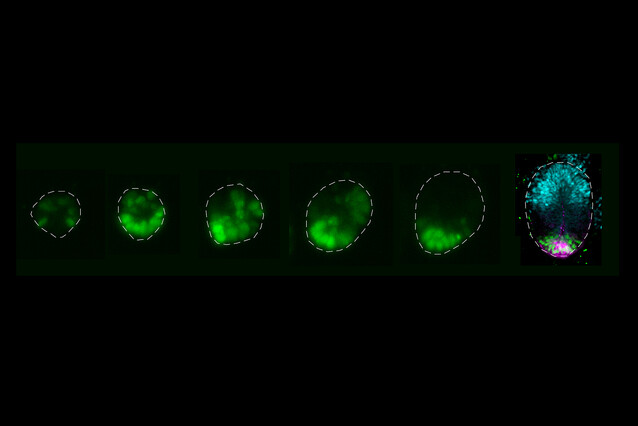How cluster competition drives floorplate formation in mouse organoids

During embryonic development, organising centres orchestrate the development of tissues and organs. Elly Tanaka’s lab has now uncovered the molecular mechanisms that guide the formation of one organising centre, the ventral floorplate, in neural tube organoids. An interplay between cell clustering and competition drives the formation of a single floor plate, as the researchers show in their study published in the journal Developmental Cell.
Every one of us developed from just a single cell: after fusion of egg and sperm, this single initial cell divides to give rise to myriads of cells, which then form the tissues and organs of the body. But how does each cell know which cell type to become, and which structure to be part of? A key role is played by groups of cells, the “organising centres”, which release factors that in turn tell other cells to differentiate, migrate or form a particular structure. To understand development fully, however, we need to understand how these organising centres form in the first place.
In a new study published in the journal Developmental Cell, Elly Tanaka and her team, with co-first authors Teresa Krammer, Hannah Stuart, and Elena Gromberg, shed light onto an alternative mechanism of how a key organising centre in the developing nervous system, the ventral floorplate, forms. Elly Tanaka and her group have moved to the Institute of Molecular Biotechnology (IMBA) as of the beginning of April, while some individual members of the lab remain affiliated with the IMP.
The development of the ventral floorplate is an essential step for the formation of the neural tube, which later gives rise to the central nervous system, to pattern and develop correctly. In the embryo, the floorplate develops in the part of the neural tube that is closest to the notochord. However, there must be more to floorplate development: The Tanaka lab previously developed organoids of the neural tube, in which the ventral floorplate develops spontaneously, even though no notochord is present. To better understand how organisers develop spontaneously, the researchers investigated how the floorplate forms in these neural tube organoids.
The scientists also tracked the appearance and behaviour of floorplate cells in neural tube organoids and identified two mechanisms that ensure that only one ventral floorplate is formed: cells that express the transcription factor FOXA2 move inside the organoid to find other FOXA2-positive cells and form multiple clusters. These clusters then compete through long-range signals to determine which one will prevail to become a floorplate.
The results highlight how some embryonic structures can organize regardless of whether other guiding components that provide structural information are present or not. “Our work shows how organisers can form, and that embryonic processes which were thought to be induced by a controlling structure – like the notochord – can actually proceed through regulative wiring of cells”, Tanaka summarises. “We also show that studying self-organization in an organoid system can give us novel insights into patterning in the developing organism, in our case, into the development of the anterior floorplate.”
Read the full story here.
Original Publication
Mouse neural tube organoids self-organize floorplate through BMP-mediated cluster competition. Teresa Krammer, Hannah T. Stuart, Elena Gromberg, Keisuke Ishihara, Dillon Cislo, Manuela Melchionda, Fernando Becerril Perez, Jingkui Wang, Elena Constantini, Stefanie Lehr, Laura Arbanas, Alexandra Hörmann, Ralph A. Neumüller, Nicola Elvassore, Eric Siggia, James Briscoe, Anna Kicheva, Elly M. Tanaka. Developmental Cell. DOI: 10.1016/j.devcel.2024.04.021
Further Reading